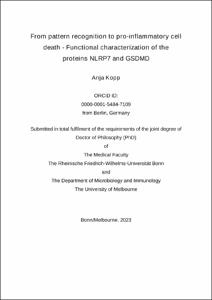Kopp, Anja: From pattern recognition to pro-inflammatory cell death - Functional characterization of the proteins NLRP7 and GSDMD. - Bonn, 2023. - Dissertation, Rheinische Friedrich-Wilhelms-Universität Bonn, University of Melbourne.
Online-Ausgabe in bonndoc: https://nbn-resolving.org/urn:nbn:de:hbz:5-73245
Online-Ausgabe in bonndoc: https://nbn-resolving.org/urn:nbn:de:hbz:5-73245
@phdthesis{handle:20.500.11811/11165,
urn: https://nbn-resolving.org/urn:nbn:de:hbz:5-73245,
author = {{Anja Kopp}},
title = {From pattern recognition to pro-inflammatory cell death - Functional characterization of the proteins NLRP7 and GSDMD},
school = {{Rheinische Friedrich-Wilhelms-Universität Bonn} and {University of Melbourne}},
year = 2023,
month = dec,
note = {Inflammasomes are cytosolic multi-protein complexes that form in response to infection or other harmful stimuli to induce innate immune responses. The core components of inflammasomes are pattern recognition receptors (PRRs) that sense conserved pathogen- or damage-associated molecular patterns. Upon recognition of their activation signal, these PRRs are able to self-oligomerize and bind to the adaptor protein apoptosis associated speck-like protein containing a CARD (ASC), which in turn recruits pro-caspase-1. Caspase-1 processes the pro-inflammatory cytokines IL-1ß and IL-18 into their mature forms and cleaves the protein gasdermin D (GSDMD), causing the N-terminal domain of GSDMD to oligomerize and form large pores in the plasma membrane. GSDMD pore formation leads to cytokine release, and ultimately cell death, known as pyroptosis.
Among the PRRs involved in inflammasome formation, members of the NOD-like receptor protein family, including NLRP1, NLRP3 and NLRP6, are best desribed. However, the role of the NLRP family member NLRP7 in inflammasome activation remains largely unknown. Here, HEK cell-based inflammasome reconstitution assays were used to investigate its role as an inflammasome-assembling PRR. In contrast to other well-established inflammasome forming PRRs such as NLRP3, NLRC4 and pyrin, neither overexpression nor stimulation of NLRP7 induced ASC speck formation in HEK cells. Co-expression of NLRP7 together with NLRP3 reduced NLRP3-mediated ASC speck formation, whereas, co-expression of NLRP7 together with NLRC4 and pyrin increased the ASC speck formation induced by these PRRs. To provide a new tool for studying NLRP7, NLRP7-targeting nanobodies were generated. Eight high affinity binders were identified that recognize two distinct epitopes on the NLRP7 pyrin domain. The nanobodies can be expressed intracellularly as intrabodies and can be used as primary detection agents in western blots.
GSDMD is the key mediator of pyroptosis which occurs downstream of all inflammasome pathways. Pyroptosis is observed in many diseases with excessive inflammation, making GSDMD an attractive drug target. In this study, six GSDMD binding nanobodies were characterized in terms of their binding XIX affinity, stability, and effect on GSDMD pore formation. Three of the nanobodies inhibited GSDMD pore formation in a liposome leakage assay, although caspase cleavage was not perturbed. The crystal structure of human GSDMD in complex with two nanobodies, one inhibitory and one non-inhibitory, was determined at 1.9 Å resolution, providing detailed insights into the GSDMD-nanobody interactions and epitope binding. The pore formation is sterically blocked by one of the nanobodies that binds to the oligomerization interface of the N-terminal domain in the multi-subunit assembly. These biochemical and structural findings provide new tools for studying inflammasome biology and build a framework for the design of novel GSDMD targeting drugs.},
url = {https://hdl.handle.net/20.500.11811/11165}
}
urn: https://nbn-resolving.org/urn:nbn:de:hbz:5-73245,
author = {{Anja Kopp}},
title = {From pattern recognition to pro-inflammatory cell death - Functional characterization of the proteins NLRP7 and GSDMD},
school = {{Rheinische Friedrich-Wilhelms-Universität Bonn} and {University of Melbourne}},
year = 2023,
month = dec,
note = {Inflammasomes are cytosolic multi-protein complexes that form in response to infection or other harmful stimuli to induce innate immune responses. The core components of inflammasomes are pattern recognition receptors (PRRs) that sense conserved pathogen- or damage-associated molecular patterns. Upon recognition of their activation signal, these PRRs are able to self-oligomerize and bind to the adaptor protein apoptosis associated speck-like protein containing a CARD (ASC), which in turn recruits pro-caspase-1. Caspase-1 processes the pro-inflammatory cytokines IL-1ß and IL-18 into their mature forms and cleaves the protein gasdermin D (GSDMD), causing the N-terminal domain of GSDMD to oligomerize and form large pores in the plasma membrane. GSDMD pore formation leads to cytokine release, and ultimately cell death, known as pyroptosis.
Among the PRRs involved in inflammasome formation, members of the NOD-like receptor protein family, including NLRP1, NLRP3 and NLRP6, are best desribed. However, the role of the NLRP family member NLRP7 in inflammasome activation remains largely unknown. Here, HEK cell-based inflammasome reconstitution assays were used to investigate its role as an inflammasome-assembling PRR. In contrast to other well-established inflammasome forming PRRs such as NLRP3, NLRC4 and pyrin, neither overexpression nor stimulation of NLRP7 induced ASC speck formation in HEK cells. Co-expression of NLRP7 together with NLRP3 reduced NLRP3-mediated ASC speck formation, whereas, co-expression of NLRP7 together with NLRC4 and pyrin increased the ASC speck formation induced by these PRRs. To provide a new tool for studying NLRP7, NLRP7-targeting nanobodies were generated. Eight high affinity binders were identified that recognize two distinct epitopes on the NLRP7 pyrin domain. The nanobodies can be expressed intracellularly as intrabodies and can be used as primary detection agents in western blots.
GSDMD is the key mediator of pyroptosis which occurs downstream of all inflammasome pathways. Pyroptosis is observed in many diseases with excessive inflammation, making GSDMD an attractive drug target. In this study, six GSDMD binding nanobodies were characterized in terms of their binding XIX affinity, stability, and effect on GSDMD pore formation. Three of the nanobodies inhibited GSDMD pore formation in a liposome leakage assay, although caspase cleavage was not perturbed. The crystal structure of human GSDMD in complex with two nanobodies, one inhibitory and one non-inhibitory, was determined at 1.9 Å resolution, providing detailed insights into the GSDMD-nanobody interactions and epitope binding. The pore formation is sterically blocked by one of the nanobodies that binds to the oligomerization interface of the N-terminal domain in the multi-subunit assembly. These biochemical and structural findings provide new tools for studying inflammasome biology and build a framework for the design of novel GSDMD targeting drugs.},
url = {https://hdl.handle.net/20.500.11811/11165}
}






